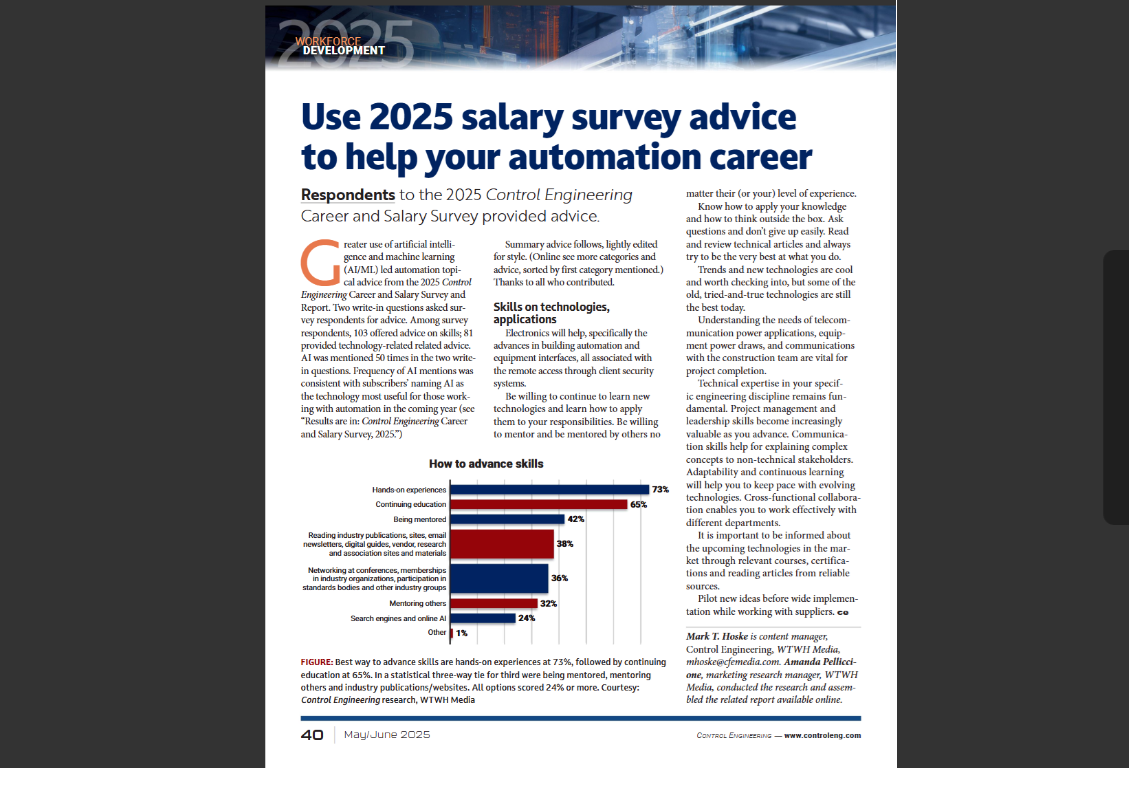Control Engineering research provides another opportunity for subscribers to share advice and think again about automation controls and instrumentation. Learn more about automation planning, interoperability, real-time controls and energy efficiency by design ... and thank you.

Controls, automation research insights
- Understand that Control Engineering shares subscriber research knowledge and advice to create more efficient and effective automation and controls applications.
- Learn how to improve automation planning, energy efficiency along with the value of interoperability for automation, controls.
- Explore a mini case study on real-time process monitoring, process control.
Control Engineering subscribers gladly shared advice about automation, control and instrumentation technologies and applications as part of research to create 2025 editorial calendar topics. As we continue planning for 2026, I didn’t want to miss the chance report on (and thank you for) the 2025 automation advice. Subscriber advice excerpts, edited for length and clarity, follow. In the online version of this article, find Control Engineering resources with more on related automation topics.
Improve automation planning, sourcing
Extensive planning and testing of new automation systems to replace obsolete systems is critical for success.
Communications for input/output (I/O) devices and operator interfaces should be validated offline before taking the existing system down.
Plans for rewiring should be detailed and easy for electricians to understand.
Controls diagrams must be kept concise and must closely match the sequence of operations. Guides on how to develop controls diagrams and the required level of detail are helpful to engineers.
The supply chain still has troubles. Alternative [nontraditional] acquisition methods can be beneficial.
Create better plans and specifications with more details for better automation installations.
1. Teamwork is more important than ever. 2. Technical merit of automation technologies must not be allowed to be superseded by cost/economy considerations. 3. Quality cannot be compromised even if it may temporarily seem to be less cost-effective.
Require interoperability of automation, controls
Like industrial-network-certified products, require that control systems have open-protocol certifications for seamless integration and interchangeability of various control equipment at supervisory layer and on the management layer.
Mini case study on real-time process monitoring, process control
We implemented run-to-run (R2R) control for the etch process in a chip manufacturing facility. The etch process is critical for precisely removing material to create the desired circuit patterns on the wafer. Traditionally, the etch recipe was static, but slight variations in factors like temperature and pressure could lead to inconsistencies in etch depth. Real-time monitoring helped improve process control. We integrated sensors to collect real-time data on chamber conditions like pressure, temperature and etch rate during each wafer run. Data analysis and modeling: We developed a statistical model that correlated sensor data with etch depth. This allowed us to predict the final etch depth based on the initial conditions of each run. Dynamic recipe adjustments: The R2R control system analyzed sensor data in real time and made minor adjustments to the etch recipe (such as adjusting etch time) to ensure the desired etch depth was achieved for each wafer. Results were significant: Improved yield: R2R control minimized etch depth variations, leading to a noticeable increase in the number of good chips per wafer. Reduced scrap rate: By proactively adjusting the etch recipe, we minimized the risk of over-etching or under-etching, which can render wafers unusable. Enhanced process stability: The system’s ability to adapt to slight variations in process conditions ensured consistent and reliable etching across multiple production runs. By leveraging real-time data and process models, control engineers can achieve tighter process control, improve yield and optimize overall production efficiency.
Integrate energy savings, power considerations in automation designs
Optimize systems for minimizing energy consumption.
More details about controls systems for generators and hybrid power plants are helpful.
Put devices and systems into low-energy mode (or turn them off, when feasible) when not in use to improve revenue streams.
Consider designing-in energy savings to reduce costs and improve performance.
Automation, industrial networking, safety, information sharing
Sharing basic automation knowledge with co-workers new to control engineering can help.
Control Engineering is a good periodical. Personally, I prefer on-site data storage to cloud-based anything.
Knowing about safety controllers and levels of safety on a machine are useful.
A good decision in one of the latest automation projects was to isolate high-throughput network devices from the customer’s network through a bridge to minimize connection and throughput problems.
Automation projects are among areas taking most of my time. You are doing a great job in providing resources.
Keep sharing automation wisdom
Me: You’re certainly welcome. And thank you for sharing your knowledge with peers. (Please think again about doing so, if you haven’t recently.)
Mark T. Hoske is editor-in-chief, Control Engineering, WTWH Media, [email protected].




